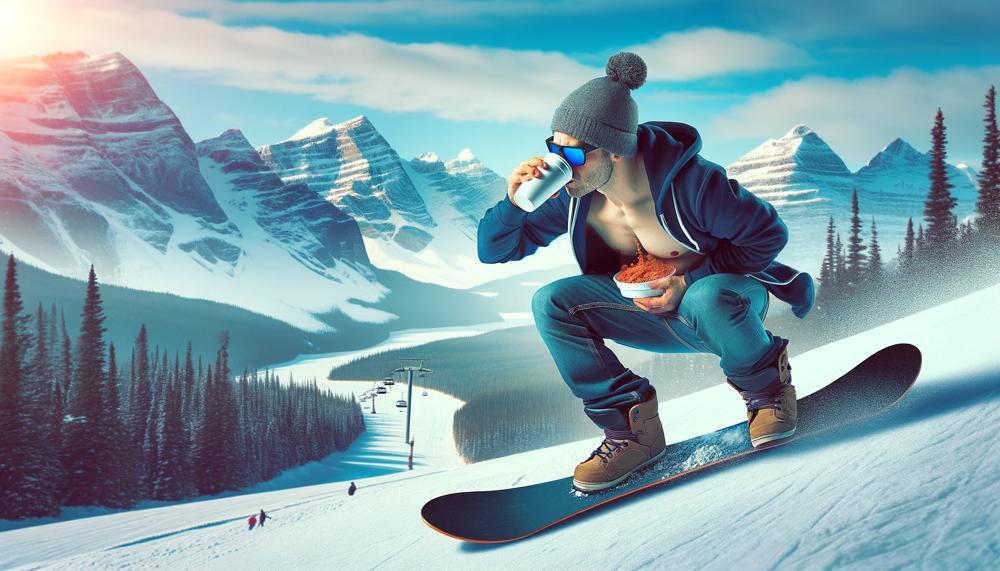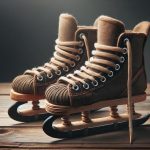Are you a die-hard snowboarder? Or perhaps contemplating taking up the exhilarating sport? While shredding through powdery slopes and flying over jumps can be an adrenaline-fueled rush, it’s crucial to consider the potential toll on your body. Specifically, your hips may bear the brunt of this high-octane activity.
So, is snowboarding bad for your hips?
Yes, snowboarding can be bad for your hips. The repetitive motion and increased resistance of snow can make winter particularly hazardous to the hips. According to a 10-year study from 1992 to 2002, snowboarders have a five times higher incidence of hip dislocation than skiers. Hip injuries can be up to 30% in professional snowboarders during a professional season.
But don’t let these risks deter you from hitting the slopes. By being mindful of your body and taking proper precautions, you can minimize the impact of snowboarding on your hips. In this blog post, we’ll delve into some helpful tips for preventing hip injuries while still relishing all that snowboarding has to offer.
So, grab your board, buckle up, and let’s hit the snowy trails together.
Is Snowboarding Bad For Your Hips?
Contents
- 1 Is Snowboarding Bad For Your Hips?
- 2 Understanding Snowboarding and its Impact on the Hips
- 3 Common Hip Injuries in Snowboarding
- 4 Factors that Contribute to Hip Injuries in Snowboarding
- 5 Minimizing Risks: Warm-Up Exercises and Proper Equipment
- 6 The Importance of Proper Form in Preventing Hip Injuries
- 7 Listening to Your Body: Managing Fatigue and Taking Breaks
- 8 Conclusion
The potential hazards to your hips while engaging in snowboarding activities include hip injuries, hip dislocation, and chronic hip problems such as bursitis and osteoarthritis. These risks can be avoided or reduced by wearing protective gear, implementing proper technique, maintaining a high level of physical fitness, and being mindful of the terrain conditions.
In addition, incorporating adequate warm-up exercises, utilizing well-fitting equipment, and listening to your body’s cues can also play a crucial role in preventing hip injuries while partaking in snowboarding.
It’s essential to note that wearing protective gear is crucial when snowboarding to minimize the risk of hip injuries. Protective gear such as helmets, wrist guards, and padded shorts can provide added cushioning and support to your hips during a fall or impact.
It’s also crucial to practice proper technique while snowboarding, ensuring that you maintain a stable and balanced position to reduce the strain on your hips.
Understanding Snowboarding and its Impact on the Hips
Snowboarding is a thrilling and ever-growing sport that has captured the attention of many over the years. It involves gliding down snow-covered slopes on a snowboard attached to your feet, offering an exhilarating experience.
However, with this excitement comes the risk of injuries, particularly those that can affect your hips. In this section, we will dive into how snowboarding can impact the health of your hips and whether it is something to be concerned about.
The Impact of Snowboarding on Hip Health
Falls are an inevitable part of snowboarding, regardless of your level of expertise. And when it comes to falling, the hips are one of the most vulnerable areas of the body. The natural instinct is to use your hands to break the fall, putting immense pressure on your wrists and shoulders. This often results in hip injuries as well.
Furthermore, collisions with other snowboarders or objects on the slopes can also lead to hip injuries. The force from these impacts can cause dislocations, bursitis (inflammation of the fluid-filled sacs that cushion the joints), and even osteoarthritis (a condition where the cartilage in the joints wears down).
Is Snowboarding Damaging for Hip Health?

While snowboarding has its risks, it does not necessarily mean it is a dangerous sport for your hips. With proper precautions, the sport can be enjoyed safely by people of all ages.
Preventing Hip Injuries while Snowboarding
To prevent hip injuries while snowboarding, taking certain precautions is essential. Firstly, wearing protective gear such as padded shorts and hip pads can help cushion your hips in case of a fall. Additionally, using proper technique and staying physically fit can also reduce the risk of hip injuries. Warming up before hitting the slopes and listening to your body’s cues can also help prevent injuries.
Moreover, being aware of terrain conditions and avoiding high-risk areas can also minimize the chances of collisions and falls. Taking breaks throughout the day and staying hydrated can also help prevent fatigue, which can lead to accidents on the slopes.
In case of an injury, seeking immediate medical attention, especially for head injuries, is crucial. For other types of injuries, such as hip fractures or dislocations, a visit to the doctor may be necessary.
Common Hip Injuries in Snowboarding
Snowboarding is an exhilarating sport that comes with its risks. While it can be a thrilling experience, falls or collisions with objects or the ground can lead to common hip injuries.
It is crucial to be aware of these injuries and take steps to prevent them.
Wrist Fractures and Sprains:
Wrist fractures and sprains are among the most common hip injuries in snowboarding.
The air and compression when weight is added to it create a limit as to how much weight it can take, making it essential to wear protective gear such as wrist guards and supportive snowboard boots.
Broken Ankles:
Snowboarding also poses a risk of broken ankles, which can occur due to falls or collisions. Wearing knee braces and maintaining physical fitness can help reduce the chances of this injury.
Head Injuries:
Head injuries, such as concussions, can have severe consequences if not addressed immediately.
Wearing a helmet with a face guard can minimize facial injuries like cuts and abrasions.
Shoulder and Knee Injuries:
Falls while snowboarding can also result in shoulder and knee injuries.
To prevent these injuries, proper falling techniques and physical fitness are crucial.
Spinal Injuries:
Spinal injuries are another concern for snowboarders, but they can be prevented by staying aware of surroundings and being cautious of obstacles on the slopes.
Tailbone Injuries:
Tailbone injuries are common among snowboarders due to falls on the hard-packed snow surface. Wearing protective gear like padded shorts can help minimize the risk of this injury.
Hand and Finger Injuries:
Snowboarders also have a higher risk of hand and finger injuries due to falls or collisions. Wearing gloves or mittens can provide some protection against these types of injuries.
Fractures in the Outer Talus Bone of the Ankle:
Fractures in the outer talus bone of the ankle can occur due to falls or collisions while snowboarding. In case of an injury, immediate RICE treatment (Rest, Ice, Compression, Elevation) is recommended.
To prevent common hip injuries in snowboarding, it is essential to wear protective gear such as wrist guards, supportive snowboard boots, helmets, and knee braces. It is also important to follow safety guidelines and maintain physical fitness.
Factors that Contribute to Hip Injuries in Snowboarding
These types of accidents can result in various injuries including bruises, strains, or even fractures in the hip area. Moreover, snowboarders are also exposed to harmful UV rays that reflect off the snow, which can lead to sunburn and eye damage.
To ensure safety while snowboarding, it is crucial for snowboarders to equip themselves with protective gear. Additionally, they should also practice proper falling techniques and maintain situational awareness to minimize the risk of injuries. It is also important for snowboarders to follow safety guidelines and regulations to stay safe on the slopes.
One of the most common causes of hip injuries among snowboarders is falling. Whether it’s a beginner or an experienced rider, everyone is prone to falls. In fact, even professional snowboarders fall multiple times during a single session. Therefore, it is essential for snowboarders to learn proper falling techniques to prevent injuries. This includes avoiding using their hands to break a fall and instead rolling onto their back or shoulder.
Furthermore, collisions with objects such as trees or rocks can also result in hip injuries. Snowboarders should always be aware of their surroundings and avoid risky areas with potential obstacles. Maintaining situational awareness can help prevent accidents and ultimately reduce the risk of injuries.
In addition to physical injuries, snowboarders are also exposed to harmful UV rays while on the slopes. The sun’s reflection off the snow can cause sunburns and eye damage if proper precautions are not taken. Wearing sunscreen, sunglasses, and a helmet with a visor can help protect against these harmful rays.
Minimizing Risks: Warm-Up Exercises and Proper Equipment
Minimizing the possibility of hip injuries while snowboarding necessitates a combination of warm-up exercises and proper equipment. These are crucial for preventing injuries and ensuring a safe and enjoyable snowboarding experience. To minimize the risk of hip injuries while snowboarding, here are some recommended warm-up exercises and proper equipment:
Warm-Up Exercises:
| Jumping Jacks | Squat Jumps | Lunges |
| High Knees | Arm Circles | Mountain Climbers |
| Leg Swings | Hip Rotations | Planks |
| Dynamic Stretching (e.g., leg swings, arm circles) |
Proper Equipment:
- Helmet: A helmet is an essential item for snowboarders as it protects the head from impacts and collisions.
- Goggles: Goggles shield the eyes from wind, snow, and harmful UV rays, ensuring clear vision while riding.
- Wrist Guards: Wrist guards aid in preventing wrist injuries by stabilizing the wrists during falls.
- Knee Pads: Knee pads offer additional cushioning and support to avoid knee injuries.
- Hip Pads: Hip pads are specifically designed to safeguard the hips from impacts and falls.
- Snowboard Boots: Properly fitted snowboard boots provide support and keep the feet warm and dry.
- Snowboard Bindings: Bindings secure the boots to the snowboard, providing control and stability.
- Protective Clothing: Wearing layers of protective clothing, such as waterproof jackets and pants, can prevent discomfort and hypothermia.
By incorporating these recommended warm-up exercises and using the proper equipment, snowboarders can minimize the risk of hip injuries while enjoying their time on the slopes. It is also vital to listen to your body and take breaks when needed to prevent overexertion and fatigue.
Always check the weather conditions and follow safety guidelines while snowboarding.
The Importance of Proper Form in Preventing Hip Injuries
When it comes to snowboarding, proper form is key in preventing hip injuries. By ensuring that your weight is evenly distributed and maintaining a stable center of gravity, you can significantly reduce the risk of injury. It’s also important to use the right amount of pressure on the board to avoid straining your hips.
Snowboarding might seem like a simple sport, but it actually requires a lot of technique and skill. Without proper form, you could easily end up with a hip injury that could put you out of commission for weeks or even months. That’s why it’s crucial to pay attention to your form while on the slopes.
One way to maintain proper form is by distributing your weight evenly between both feet. This will help you stay balanced and in control while snowboarding. Additionally, keeping your center of gravity low and stable will also help prevent falls and possible hip injuries.
Another important aspect of proper form is using the right amount of pressure on the board. Too much pressure can put strain on your hips and cause injury, while too little can make it difficult to control the board. Finding the right balance is key in preventing hip injuries while snowboarding.
Listening to Your Body: Managing Fatigue and Taking Breaks
When it comes to snowboarding, listening to your body can be a crucial factor in managing fatigue and taking breaks. By paying attention to the signals your body is sending, you can effectively recognize signs of exhaustion and identify areas of strain in your body. This will allow you to take necessary breaks and give your body time to rest and recover.
It’s important to understand that fatigue is not just a physical issue, but also a mental one. When your body is overworked, it’s natural for your mind to become fatigued as well. This can lead to poor decision-making and accidents on the slopes. By listening to your body, you can avoid pushing yourself too hard and risking injury.
One way to listen to your body is by recognizing physical cues such as muscle soreness, shortness of breath, and dizziness. These are all signs that your body needs a break and should not be ignored. Additionally, pay attention to any areas of strain or discomfort in your body, as this could indicate areas that need extra care during breaks.
Taking breaks may seem counterintuitive when you’re trying to make the most of your time on the mountain, but it’s actually essential for maintaining energy levels and preventing burnout. Even short breaks every hour or so can make a big difference in how you feel throughout the day.
Remember that snowboarding is meant to be enjoyable, not exhausting. By listening to your body and taking breaks when needed, you can ensure that you have a fun and safe day on the slopes.
Also Read: How To Break In Snowboard Boots At Home?
Conclusion
In conclusion, snowboarding can provide an exhilarating rush and a sense of freedom on the slopes. However, it’s crucial to consider the potential impact on your body, especially your hips. The constant twisting and turning, repetitive movements, falls and crashes, improper form and technique, and ignoring discomfort can all contribute to hip pain and injury. But fear not – with proper precautions and mindfulness, you can minimize these risks and still enjoy the thrill of snowboarding.
To ensure your safety while shredding the powdery slopes, always wear protective gear such as helmets and pads. It may not be the most stylish look, but it could save you from serious injury. Additionally, practicing proper technique and maintaining physical fitness can help prevent strain on your hips. Don’t forget to warm up before hitting the slopes to prepare your muscles for the intense movements.
Another essential aspect is using well-fitting equipment that supports your body properly. Ill-fitting boots or bindings can put unnecessary stress on your hips. And most importantly, listen to your body’s cues for breaks and rest – pushing through pain or discomfort can lead to more severe injuries.
Don’t let these precautions discourage you from experiencing the thrill of snowboarding. Just remember to prioritize safety while still relishing in all that this sport has to offer. So grab your board, buckle up, and hit the snowy trails with caution and care.






